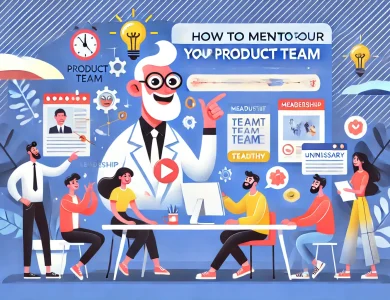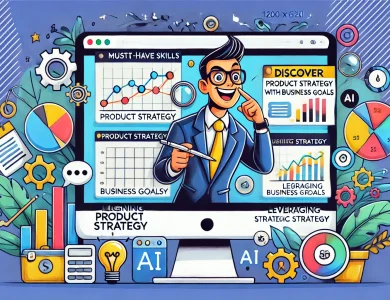Product Management Specialties: A Comprehensive Guide for Modern PMs

In the evolving world of product management, roles are diversifying into multiple specialties, each addressing specific challenges and responsibilities.
From Core PMs to Web3 and API-focused roles, these specialties drive business objectives while aligning user needs and technological advances. Here’s an in-depth look at these distinct product management roles and their impact on modern businesses.
1. Core Product Manager
Foundational Product Management Responsibilities
Core PMs manage products end-to-end, from concept to launch and iteration. Their work involves ensuring product success by aligning business goals with user needs while collaborating across various departments.
Defining Product Vision and Roadmaps
A core PM is responsible for setting the product’s long-term strategy, clearly defining its vision, and creating actionable roadmaps that guide the product’s growth and evolution.
Balancing Business Goals with User Needs
The challenge lies in balancing the profitability and usability of the product. Core PMs often use prioritization frameworks to ensure both business and user expectations are met.
Managing Cross-Functional Teams
Core PMs act as the bridge between engineering, design, marketing, and sales. Best practices for managing these relationships include setting clear goals, maintaining strong communication, and using collaboration tools to track progress.
2. Growth Product Manager
Introduction to Growth Product Management
Growth PMs focus on accelerating product growth by driving user acquisition, engagement, and retention. Their goal is to scale the product in a way that ensures long-term value.
Growth Loops and Viral Mechanisms
Growth PMs design mechanisms like referral programs and user-generated content to drive exponential user growth and retention.
Data-Driven Experimentation and A/B Testing
A critical part of the role is experimenting with product features and optimizing them using A/B testing. Data-driven decision-making helps in finding the best paths to scaling the product.
AI-Powered Growth Strategies
AI tools help Growth PMs analyze user behavior, segment markets, and create personalized growth strategies. These tools are vital in optimizing user journeys and predicting customer needs.
3. Platform Product Manager
Platform Thinking and Ecosystem Development
Platform PMs focus on creating ecosystems where third-party developers, partners, and users generate value. Platforms allow multiple stakeholders to contribute to growth, making them scalable through network effects.
Designing APIs and Developer Support Systems
Platform PMs build robust APIs and provide developer support to encourage external developers to build on their platform. Developer engagement is crucial for the platform’s success.
Scaling Platforms with Network Effects
Using network effects, Platform PMs ensure that both the supply and demand sides of the platform grow simultaneously. This balance is key to scaling.
AI for Platform Optimization and Monitoring
AI helps Platform PMs optimize performance, allocate resources efficiently, and improve user engagement through real-time data analysis.
4. Innovation Product Manager
Driving Product Innovation: The Role of Innovation PMs
Innovation PMs push the boundaries of product development by fostering creativity and innovation. They focus on introducing new, disruptive products that capture market attention.
Integrating AI and Emerging Technologies
AI, machine learning, and blockchain are at the forefront of product innovation. Innovation PMs leverage these technologies to stay ahead of the curve and meet evolving market needs.
Building a Culture of Innovation
Creating a culture where experimentation and creativity thrive is key to success. Innovation PMs encourage rapid prototyping and iterative processes that reduce risks.
Best Practices for Rapid Prototyping and Iteration
By using quick prototypes, Innovation PMs gather feedback, validate ideas, and ensure that only the most viable solutions move forward to development.
5. SaaS Product Manager
Introduction to SaaS Product Management
SaaS PMs manage subscription-based software products, where the focus is on continuous engagement, retention, and scaling the product for different types of users.
Optimizing User Onboarding and Engagement
AI-powered onboarding ensures that each user experience is personalized and efficient. SaaS PMs focus on reducing churn by improving user engagement at every touchpoint.
Key Metrics for SaaS Product Success
Metrics such as Monthly Recurring Revenue (MRR), Customer Lifetime Value (CLV), and Churn Rate are essential in measuring SaaS product success. AI can help predict trends and optimize strategies.
Scaling SaaS Products for Enterprise Customers
Enterprise customers require more complex solutions, including security and customization. SaaS PMs must balance scalability with meeting enterprise-level needs.
6. Web3 Product Manager
Understanding Web3 and Blockchain Technology
Web3 PMs build decentralized applications (dApps) using blockchain technology. Their work involves managing smart contracts, tokenomics, and ensuring security across decentralized platforms.
Tokenomics and Incentive Design
Web3 PMs design token ecosystems to incentivize user participation. Proper tokenomics encourage long-term engagement and decentralized governance.
Managing Decentralized Platforms
Decentralized platforms pose unique challenges, such as governance and user onboarding. Web3 PMs focus on creating trustless systems where security is paramount.
Best Practices for Designing Trustless Systems
Trustless systems eliminate intermediaries by using blockchain. Web3 PMs must ensure the transparency, security, and user-friendliness of these systems.
7. API Product Manager
Building Developer-Centric APIs
API PMs are responsible for building user-friendly and scalable APIs. Their focus is on ensuring that developers can easily integrate and use the APIs in various ecosystems.
API Monetization Strategies
Different monetization models for APIs—subscription-based, pay-per-call, or freemium—allow companies to generate revenue through APIs. PMs focus on aligning these models with the business strategy.
Ensuring API Security and Compliance
API security is crucial, especially with data privacy regulations like GDPR. API PMs must enforce secure access through OAuth, rate limiting, and strong compliance protocols.
Driving API Adoption with AI-Powered Developer Tools
AI-driven documentation, real-time support, and code examples enhance API adoption. These tools help developers quickly understand and integrate APIs into their applications.
8. Payments Product Manager
Building Robust Payments Solutions
Payments PMs manage the infrastructure for smooth transactions, focusing on security, ease of use, and reducing friction during checkout.
Optimizing Conversion Rates with AI
AI can optimize payment flows, predict customer preferences, and reduce fraud, which in turn increases conversion rates.
Cross-Border Payments and Currency Solutions
Managing payments across borders introduces complexities with currency conversions and compliance. AI can streamline currency management and automate the process.
Compliance and Regulatory Challenges in Payments
Payments PMs must ensure that their products comply with regulatory standards such as PCI-DSS and GDPR, especially in cross-border transactions.
9. Data Product Manager
Data as a Product: Building Data Pipelines
Data PMs focus on the creation and management of data pipelines, ensuring that data is clean, structured, and accessible for product decision-making.
AI for Data-Driven Product Decisions
AI can analyze large datasets to deliver actionable insights. Data PMs leverage predictive analytics to improve decision-making in real-time.
Ensuring Data Privacy and Compliance
Data privacy regulations such as GDPR and CCPA require strict adherence. Data PMs must ensure compliance while still enabling data-driven strategies.
Monetizing Data Products
Data PMs explore revenue opportunities through premium data services, such as analytics dashboards, or by offering Data-as-a-Service (DaaS) models.
10. Risk & Compliance Product Manager
Navigating Risk in Product Development
Risk and Compliance PMs ensure that the product complies with regulations and mitigates risks related to fraud, security breaches, and regulatory issues.
AI-Powered Fraud Detection and Risk Management
AI tools can predict and prevent fraud by analyzing patterns and flagging suspicious activity. Risk PMs must optimize these tools to ensure proactive risk management.
Ensuring Regulatory Compliance in Highly Regulated Industries
Industries like healthcare and finance have strict compliance requirements. Risk PMs must develop products that meet these regulations while maintaining innovation.
Balancing Innovation with Compliance
Risk and Compliance PMs must strike a balance between innovating and adhering to regulations. Streamlined compliance processes enable faster product development without legal risks.
11. User Experience (UX) Product Manager
Creating User-Centered Product Experiences
UX PMs focus on building intuitive and accessible products that provide an exceptional user experience. They collaborate closely with designers to ensure products are user-friendly.
AI-Driven Personalization for Improved UX
AI tools help UX PMs personalize user experiences by tailoring content, recommendations, and interactions to individual user preferences and behavior.
Conducting UX Research with AI Tools
AI-powered tools for UX research enable PMs to analyze user feedback, conduct sentiment analysis, and identify pain points quickly.
Measuring UX Success with Key Metrics
UX PMs track performance using metrics such as Net Promoter Score (NPS), usability scores, and task completion rates to continuously improve the user experience.
12. Mobile Product Manager
Managing Mobile-First Products
Mobile PMs manage products specifically for mobile devices, focusing on app store optimization, cross-platform development, and user retention.
AI for Optimizing Mobile User Journeys
AI helps Mobile PMs optimize the user journey by providing predictive recommendations, voice search, and personalized content.
Tracking Mobile App Performance with AI
Real-time performance monitoring with AI helps Mobile PMs identify and resolve issues such as crashes, latency, and user drop-off points.
Mobile Payments and Security Best Practices
Mobile PMs must ensure that payments are secure, encrypted, and frictionless. This includes managing mobile payment gateways and ensuring the highest security standards.
13. Marketing Product Manager
Aligning Product and Marketing Strategies
Marketing PMs align product goals with marketing efforts to ensure successful launches, customer acquisition, and retention.
AI-Driven Marketing Automation
AI tools automate marketing efforts, such as email campaigns, user segmentation, and ad targeting, providing data-driven insights for optimal performance.
Optimizing Product Launches with AI Insights
AI helps Marketing PMs optimize product launches by analyzing market trends, user behavior, and competitor activity.
Measuring the Impact of Marketing Initiatives
Marketing PMs measure the success of their initiatives through AI-powered tools that track customer engagement, ROI, and the effectiveness of marketing campaigns.




